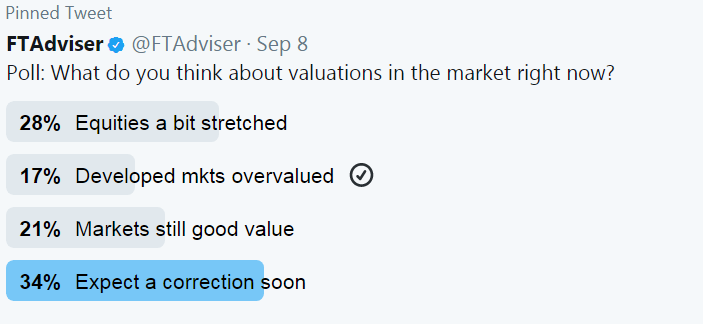
Can investors trust valuations right now?
Valuations. They're pretty high right now in many equity markets around the world. But does that mean these stocks are overvalued, fair value or in four-alarm-fire territory?
Likewise, volatility, as measured by the Vix index showing the movement in the S&P 500 - often a bellwether for other equity market indices - has been spiking upwards ever since August, when "fire and fury" comments from the US President caused geopolitical uncertainty.
The Vix rose from a range between 8 and 9 up to 11.11 on 9 August and hitting 16 on 10 August, and is now settling back around 10.
But while politicians can make market-shaking statements, and while the effects of global disasters can cause short-term market tremors, what does the future really hold for investors?
This report aims to show exactly whether investors can trust valuations, where valuations may be slightly frothy and how advisers can help shore up their clients' portfolios against any future market shocks.
As Marcus Brookes, head of the multi-manager team at Schroders comments, while the US market is extremely expensive right now, other markets such as Europe and some emerging countries do look better value.
To find out how Mr Brookes is positioning portfolios, watch the video interview he gave to FTAdviser about valuations, volatility and the virtue of diversification.
Simoney Kyriakou is content plus editor for FTAdviser
Advisers go on the defensive over high valuations and market volatility
Equity market valuations look overstretched according to some commentators, prompting financial advisers to move client portfolios to a risk-off position.
Philip Milton, chartered wealth manager for PJ Milton, said too much money is flowing to some of the highest income-paying equities in the UK stockmarket.
Keen to avoid what he sees as the risk of being in a highly concentrated stock market, and due to the poor returns on fixed income, he has been moving out of high-risk bonds and equities into infrastructure investments to diversify his clients' portfolios, to lower risk and maximise income.
He said: "These will provide diversification and uncorrelated exposure away from equities to help conserve capital values as much as producing above-interest income returns for clients."
Mr Milton said he had been "concerned of late" by the fact some of the UK's biggest funds have invested heavily into companies such as AstraZeneca, which recently had a "big negative hit" after it published poor results.
"Did you know that 30 of the 87 funds in the Investment Association's Income sector had Astra as a top 10 holding?
"Twenty-eight had British American Tobacco in that position. The same overpriced stocks have been chased higher, too, both by ‘cheap’ passive, index-tracking funds and exchange-traded funds, and because of the weight of money being subscribed to this sector, often by unsuspecting investors."
His comments echoed the sentiment of advisers polled by FTAdviser Talking Point, 34 per cent of whom believe equity markets are due a correction soon.
A further 28 per cent of advisers considered equity markets to be "a bit stretched" at the moment.
Only 17 per cent of respondents thought there was a distinct difference between developed markets and emerging markets, with 21 per cent claiming markets were still "good value".

Advisers believe what goes up is soon to come down...
Likewise, fund managers and analysts have warned investors to be canny over valuations.
Stephanie Butcher, fund manager for Invesco Perpetual, commented: "As we have described frequently before, focus on valuation is the over-riding philosophy that informs allocations.
"To our minds over-paying for any asset, whatever its quality, is taking on additional risk."
Tanguy De Lauzon, head of capital markets & asset allocation at Morningstar Investment Management Europe, said: "The question of whether we can trust valuation metrics is a recurring theme across history that stems from the “this time it’s different” mentality.
"We know starting yields are low, growth is modest and valuations are stretched. Hence, even if valuations remain at the outer bounds of normality, the return backdrop is likely to be lower due to the compressed starting yield.
"The alternative would be for valuations to revert, where we would see negative returns followed by something closer to normality. The point here is to acknowledge is that valuations matter regardless of the stage in the cycle."
simoney.kyriakou@ft.com
The house view from Schroders:
A narrow tightrope?
There is a sense that investors are now walking a narrow tightrope.
Many investors have become convinced of a “Goldilocks” scenario where central bankers, in their wisdom, engender macro-economic conditions that are neither too hot nor too cold.
Those crowded into the winners of this bull market are (inadvertently or not) banking on this status quo persisting.
So, what might change this? What’s on either side of this metaphorical tightrope? Our base case for now is that economic data continues to improve at the margin.
The softening experienced in recent months appears to be moderating - slowly but surely allowing confidence to return.
Labour markets are increasingly tight (in other words, unemployment is low) in a number of economies – the US, UK, Germany and Japan, to name a few.
This is driving the more hawkish behaviour of central banks in recent weeks. At some stage these conditions should also spur wage inflation.
Broadly speaking this means a continuation of gradually rising interest rates in the US and growing calls for less accommodation elsewhere.
It doesn’t take a huge shift for some of the standout performers of recent years to look quite vulnerable. In this scenario, bond proxies, technology et al may well underperform.
If the recent election in the UK has taught us anything, it’s that austerity is now a dirty word to many parts of the electorate
The quarter-end rotation in equity markets back to the ‘value’ style has been welcome, albeit short-lived to date.
However, we do believe conditions are in place for this to persist for the time being.
Risks to the current consensus lie within changing politics as well. If the recent election in the UK has taught us anything, it’s that austerity is now a dirty word to many parts of the electorate.
Greater fiscal spending is something likely to be mirrored around the world. All of which adds to a less deflationary backdrop for investors.
On the flip side, though, the risks are becoming clearer. This is already the third longest economic expansion in history. It is difficult to argue that we are closer to the beginning than the end.
Gains for investors have been huge and prospective returns from here look constrained at best.
The S&P 500 in sterling terms is up circa +355 per cent since the troughs of March 2009. Clichés abound, but nothing lasts forever.
We think it’s wise to at least begin shifting emphasis towards capital preservation.
Remember, the average bear market gives back circa 50 per cent of the gains made in the proceeding bull phase.
To be clear, this is not us ringing the bell for an imminent bear market. It is however, us acknowledging that the risks have increased and we should be considering this in portfolio construction.
Nor do we necessarily think a recession is imminent. However, the balance of probabilities tells us that one is likely in the next few years.
Something that could be brought on by rising interest rates in a highly levered world.
Anecdotally, we have started hearing of some investors suggesting that the slow grind up in this market cycle means it will likely be a long drawn out downturn with plenty of warning signals.
When you hear this alarm bells should be ringing. Loudly. We are not making such assumptions. The opposite may in fact be more likely given how bullish investor positioning appears to be.
Wrapping all of this together, there is a sense that many investors are dependent on quite a narrow macro-bet for current market conditions to persist, whether they are aware of this or not.
Valuations suggest to us that the opportunity lies away from this consensus.
In portfolio terms, we are spending significant time ensuring we balance the relative attractiveness of selective equities, alongside the need for appropriate portfolio protection given the different scenarios that might unfold.
Marcus Brookes is head of the multi-manager team at Schroders
Tightrope picture: Photo by Leio McLaren on Unsplash



